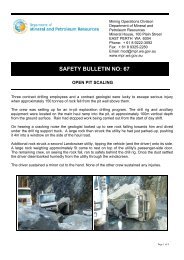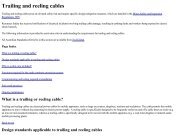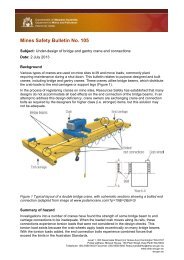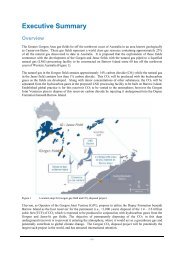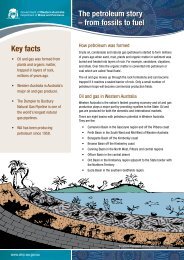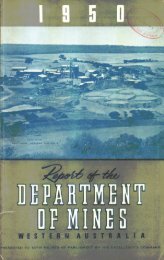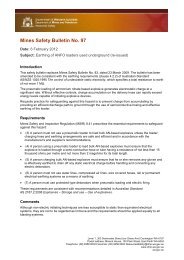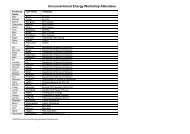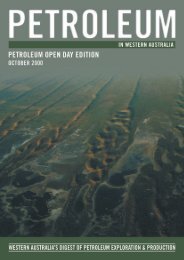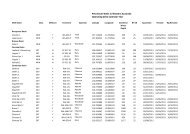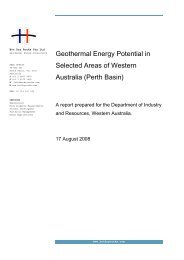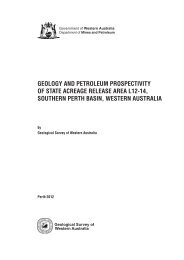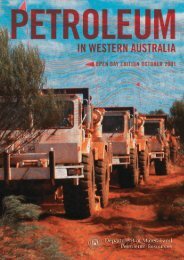Legendre Field Decommissioning Environment Plan - Department of ...
Legendre Field Decommissioning Environment Plan - Department of ...
Legendre Field Decommissioning Environment Plan - Department of ...
You also want an ePaper? Increase the reach of your titles
YUMPU automatically turns print PDFs into web optimized ePapers that Google loves.
<strong>Legendre</strong> <strong>Field</strong><br />
<strong>Decommissioning</strong> <strong>Environment</strong> <strong>Plan</strong> (DEP): Public Summary March 2011<br />
This summary has been submitted to comply with Regulation 11(7)(8) <strong>of</strong> the Offshore<br />
Petroleum and Greenhouse Gas Storage (<strong>Environment</strong>) (OPGGS(E)) Regulations<br />
2009<br />
Introduction<br />
Apache Energy Limited (Apache), on behalf <strong>of</strong> its joint venture participants Apache<br />
Northwest Pty Ltd and Santos Offshore Pty Ltd, is proposing to decommission the <strong>Legendre</strong><br />
field facilities and equipment located in Commonwealth waters <strong>of</strong>f the coast <strong>of</strong> Western<br />
Australia. The decommissioning consists <strong>of</strong> work necessary to remove the Mobile Offshore<br />
Production Unit “Ocean Legend” (MOPU), the Floating Storage and Offloading tanker<br />
“Karratha Spirit” (FSO), and the recovery <strong>of</strong> all remaining oil export equipment from<br />
Production Licence WA-20-L.<br />
Apache prepared a <strong>Decommissioning</strong> <strong>Environment</strong> <strong>Plan</strong> (DEP) for the <strong>Legendre</strong> <strong>Field</strong>, which<br />
was approved by the <strong>Department</strong> <strong>of</strong> Mines and Petroleum (DMP) on the 2nd <strong>of</strong> March 2011.<br />
This document provides a summary <strong>of</strong> the DEP for the <strong>Legendre</strong> <strong>Field</strong> and includes the<br />
proposed environmental controls to address the decommissioning activities.<br />
Location<br />
The <strong>Legendre</strong> <strong>Field</strong> is located in the <strong>of</strong>fshore Carnarvon Basin, in Commonwealth waters <strong>of</strong><br />
Western Australia, about 105 km north <strong>of</strong> Dampier (see Figure 1) and approximately 140 km<br />
northeast <strong>of</strong> the Montebello/Barrow islands Marine Conservation Reserves. The <strong>Legendre</strong><br />
facilities are situated in approximately 50m water depth. The coordinates for the facilities are:<br />
Platform Site: 019° 42’ 18.94” S 7 821 100 N<br />
116° 42’ 26.44” E 469 330 E<br />
CALM Buoy Site: 019° 41’ 21.52” S 7 822 868 N<br />
AGD94: Zone 50<br />
116° 43’ 27.27” E 471 098 E<br />
<strong>Legendre</strong> <strong>Decommissioning</strong> EP Summary.docx Page 1 <strong>of</strong> 10
Figure 1: <strong>Legendre</strong> regional location and habitat map<br />
<strong>Legendre</strong> <strong>Decommissioning</strong> EP Summary.docx Page 2 <strong>of</strong> 10
Receiving <strong>Environment</strong><br />
The following is a brief summary <strong>of</strong> the information provided in the DEP for the <strong>Legendre</strong><br />
<strong>Field</strong> <strong>Decommissioning</strong>.<br />
Physical <strong>Environment</strong><br />
The <strong>Legendre</strong> Facilities are located in the arid tropics experiencing high summer<br />
temperatures, periodic cyclones and associated rainfall. Rainfall in the region is generally<br />
low with evaporation exceeding rainfall throughout the year. Intense rainfall may sometimes<br />
occur during the passage <strong>of</strong> summer tropical cyclones and thunderstorms (NSR, 1995).<br />
Mean air temperatures over the neighbouring ocean area range from a minimum <strong>of</strong> 11°C in<br />
winter to a maximum <strong>of</strong> 37°C in summer. Due to the arid climate, daytime visibility in the<br />
area is generally greater than 5 nautical miles (SSE, 1991).<br />
The summer and winter seasons fall into the periods September-March and May-July,<br />
respectively. Winters are characterized by clear skies, fine weather, predominantly strong<br />
east to south-east winds and infrequent rain. Summer winds are more variable, with strong<br />
south-westerlies dominating. Three to four cyclones per year are typical, primarily between<br />
December and March (WNI, 1995).<br />
Wind patterns are monsoonal with a marked seasonal pattern. During October to March, the<br />
prevailing non-storm winds are from the south-west, west and north-west at an average<br />
speed <strong>of</strong> less than 10 knots, peak average speeds <strong>of</strong> 15-25 knots, and maximum speeds <strong>of</strong><br />
30 knots. Winds from the south-east to north-east quadrant are experienced at a frequency<br />
<strong>of</strong> less than 10% over these seasons. In June - August, winds are generally lighter and<br />
more variable in direction than in spring and summer. Non-storm winds prevail from northeast<br />
through to south-east at average speeds <strong>of</strong> 5-6 knots, peak average speeds <strong>of</strong> 10-15<br />
knots, and maximum speeds <strong>of</strong> 20 knots. Transitional wind periods, during which either<br />
pattern may predominate, can be experienced in April-May and September <strong>of</strong> each year.<br />
Extreme wind conditions may be generated in the area by tropical cyclones, strong easterly<br />
pressure gradients, squalls, tornadoes and waterspouts. Tropical cyclones generate the<br />
most significant storm conditions on the North West Shelf.<br />
The <strong>Legendre</strong> Production Facility and CALM buoy sites were surveyed using Side Scan<br />
Sonar, Sub-bottom Pr<strong>of</strong>iling, High Resolution Digital Seismic and gravity coring equipment<br />
prior to development and construction in 1998. The results <strong>of</strong> these surveys indicated that<br />
the seafloor is characterised by a thick sequence <strong>of</strong> carbonate rock that is overlain by<br />
unconsolidated fine to medium-grained carbonate sediments with occasional shell or gravel<br />
patches.<br />
Marine <strong>Environment</strong><br />
A search <strong>of</strong> the EPBC Act Protected Matters Search Tool identified that a total <strong>of</strong> nine listed<br />
threatened marine species may occur within the <strong>Legendre</strong> decommissioning area, with 16<br />
species listed as migratory (nine <strong>of</strong> these being the same as the threatened species). All 16<br />
species, with the exception <strong>of</strong> the humpback whale (Megaptera novaeangliae), are widely<br />
distributed and/or oceanic species and would most likely occur as vagrant transients through<br />
the <strong>Legendre</strong> <strong>Field</strong> area. The decommissioning area is not considered a habitat that is<br />
critical to the survival <strong>of</strong> any listed species. Similarly, there are no listed threatened<br />
ecological communities as defined in the EPBC Act in the vicinity <strong>of</strong> the activities. There are,<br />
however, numerous listed marine species and whales and other cetaceans listed as other<br />
matters protected by the EPBC Act that may be found within the region.<br />
The fauna listed as threatened or migratory marine species under the EPBC Act may transit<br />
through the area during decommissioning activities, however, there are no known breeding<br />
or nesting grounds within the <strong>Legendre</strong> area. The proposed timing <strong>of</strong> the decommissioning<br />
activities is outside <strong>of</strong> the peak migration periods (Table 1) <strong>of</strong> the humpback whales.<br />
<strong>Legendre</strong> <strong>Decommissioning</strong> EP Summary.docx Page 3 <strong>of</strong> 10
Seabirds and turtle species are mostly unlikely, while cetacean and shark species have a<br />
higher possibility <strong>of</strong> being present in the <strong>Legendre</strong> area.<br />
Table 1: North West Shelf biological resources, breeding cycles and human activity<br />
seasons<br />
SPECIES JAN FEB MAR APR MAY JUN JUL AUG SEP OCT NOV DEC<br />
Hawksbill turtle<br />
nesting<br />
Flatback turtle<br />
nesting<br />
Green turtle<br />
nesting<br />
Loggerhead turtle<br />
nesting<br />
Whale migration Nth Sth<br />
Whale shark<br />
aggregation<br />
Seabird nesting<br />
<strong>Legendre</strong><br />
<strong>Decommissioning</strong><br />
Key<br />
Project description / Overview<br />
Main aggregation period<br />
Peak activity, presence reliable and predictable<br />
Low level <strong>of</strong> abundance/activity/presence<br />
Activity not occurring within the area<br />
Execution timing for the decommissioning <strong>of</strong> the <strong>Legendre</strong> facilities and subsea equipment is<br />
dependent upon field economic limit. Production operations will cease and decommissioning<br />
work will commence from this commercially determined point in time. Apache currently has<br />
approval for Economic End <strong>of</strong> <strong>Field</strong> life from January 2011.<br />
The decommissioning work for the removal <strong>of</strong> the MOPU and the FSO from WA-20-L is<br />
estimated to commence on 1 March 2011, weather permitting and subject to receiving the<br />
necessary approvals. The subsea disconnection and removal activities are planned to start<br />
late March/early April 2011 with completion anticipated to be early May 2011.<br />
The <strong>Legendre</strong> facilities to be decommissioned include (see Figure 2):<br />
“Ocean Legend” MOPU;<br />
A single flexible 2.5 km oil export pipeline;<br />
83 pipeline stability saddles;<br />
1 Pipeline end manifold (PLEM);<br />
1 Underbuoy hose with floatation modules;<br />
1 Catenary anchor leg mooring buoy (CALM buoy);<br />
6 mooring piles and anchor chains;<br />
1 Floating export / import hose and hawser; and<br />
The “Karratha Spirit” FSO tanker.<br />
<strong>Decommissioning</strong> <strong>of</strong> the <strong>Legendre</strong> facilities will likely proceed in several phases (dependent<br />
upon work vessel availability); with subsea removal being executed after the MOPU “Ocean<br />
Legend” and FSO “Karratha Spirit” have departed the permit area. It is expected that the<br />
plugging and abandoning <strong>of</strong> the wells will take 47 days to complete, the flushing and<br />
<strong>Legendre</strong> <strong>Decommissioning</strong> EP Summary.docx Page 4 <strong>of</strong> 10
cleaning <strong>of</strong> the equipment 16 days, the jacking down <strong>of</strong> the MOPU 3 days and the removal<br />
<strong>of</strong> subsea equipment up to 30 days.<br />
Preparatory work prior to decommissioning will comprise <strong>of</strong> the following activities:<br />
1. Plug and abandon all 7 platform-based wells;<br />
2. Purge hydrocarbons from the MOPU petroleum production and processing<br />
equipment and the subsea oil evacuation facilities using pumped sea water. Purged<br />
fluids will be sent to the FSO Karratha Spirit;<br />
3. Clean sand and petroleum wastes from MOPU vessels and tanks and dispose<br />
onshore to an approved waste disposal facility; and<br />
4. Cut the anti-scour mats from the MOPU hull using a work class ROV and leave on<br />
the seabed floor.<br />
The <strong>Legendre</strong> facilities decommissioning scope <strong>of</strong> work will comprise <strong>of</strong> the following<br />
activities:<br />
1. Disconnect FSO Karratha Spirit from mooring hawsers and oil export and import<br />
hoses and release FSO from contract for sail away out <strong>of</strong> WA-20-L;<br />
2. Cut the cleaned flexible oil export pipeline where it is attached to the MOPU, using a<br />
work class ROV;<br />
3. Tow MOPU <strong>of</strong>f WA-20-L using tug boats prior to dry tow transport on semisubmersible<br />
heavy lift vessel (HLV) to final destination in SE Asia.<br />
The subsea decommissioning work scope will be a reversal <strong>of</strong> the installation procedure and<br />
comprise <strong>of</strong> the following activities:<br />
1. Disconnect the cleaned and flushed flowline (2.5 km) from the PLEM and recover to<br />
deck <strong>of</strong> a Multi-purpose Support Vessel (MSV);<br />
2. Recover the concrete stability saddles (83 in total) to the MSV;<br />
3. Disconnect the underbuoy hose and recover with a tow vessel;<br />
4. Disconnect the mooring chains and recover to the MSV;<br />
5. Tow the CALM buoy to Dampier with a tug;<br />
6. Remove the grouting chutes from the piles and place a cap over the six pile pad<br />
eyes; and<br />
7. Perform an ROV video survey and recover any debris lying on the seabed.<br />
The anti-scour mats and piles will be abandoned in-situ.<br />
The removal <strong>of</strong> the subsea equipment (except the mooring piles and anti-scour mats) will be<br />
carried out by TS Marine (TSM) who have contracted the DP2 Multipurpose Support Vessel<br />
(MSV), B104 / Southern Ocean.<br />
<strong>Legendre</strong> <strong>Decommissioning</strong> EP Summary.docx Page 5 <strong>of</strong> 10
Figure 2: Schematic <strong>of</strong> <strong>Legendre</strong> facilities in permit area WA-20L<br />
<strong>Legendre</strong> <strong>Decommissioning</strong> EP Summary.docx Page 6 <strong>of</strong> 10
Potential <strong>Environment</strong>al Hazards, Impacts and Proposed Management Controls<br />
This section provides a summary <strong>of</strong> the potential environmental hazards and impacts during<br />
the decommissioning activities.<br />
Table 2: Summary <strong>of</strong> Key Hazards Identified<br />
Key Hazard Source <strong>of</strong> Impact Potential Effects/Impacts<br />
Disturbance to artificial habitat and<br />
seabed<br />
Drill cuttings disturbance<br />
Artificial lighting<br />
Underwater noise<br />
Waste management<br />
Invasive marine pest species<br />
Continuous sewage and greywater<br />
discharge<br />
MOPU removal<br />
Subsea infrastructure removal<br />
Dropped objects<br />
MOPU and heavy-lift vessel<br />
mooring near Malus Island<br />
Permanent loss <strong>of</strong> artificial<br />
marine habitat.<br />
Potential for moderate loss <strong>of</strong><br />
benthic fauna habitat.<br />
Potential for medium term<br />
decrease in benthic fauna<br />
abundance at the<br />
decommissioning site.<br />
Potential for moderate turbidity<br />
effects on benthic communities.<br />
Alteration in the composition <strong>of</strong><br />
the benthic community in the<br />
immediate vicinity due to altered<br />
predator-grazing pressures.<br />
Drill cuttings piles around MOPU. Increase in suspended sediment<br />
load in the water column thereby<br />
increasing turbidity and<br />
decreasing<br />
locally.<br />
light attenuation<br />
Localised and temporary burial <strong>of</strong><br />
benthic communities and<br />
sediment anoxia within 100-200<br />
m <strong>of</strong> discharge point.<br />
Support vessels<br />
MOPU<br />
ROV<br />
Support vessel thrusters.<br />
MODU jacking system.<br />
ROV thrusters.<br />
ROV cutting tools.<br />
Helicopters.<br />
Domestic or hazardous wastes<br />
discharged or lost overboard<br />
Support vessels.<br />
Heavy-lift vessel.<br />
Support vessels<br />
Heavy-lift vessel<br />
MOPU<br />
Disorientation <strong>of</strong> turtle hatchlings<br />
and seabirds.<br />
Attraction <strong>of</strong> migrating seabirds.<br />
Pathological and physiological<br />
effects on marine biota.<br />
Disruption to behaviour pattern <strong>of</strong><br />
marine fauna.<br />
Avoidance <strong>of</strong> noise source.<br />
Localised nutrient enrichment.<br />
Localised and temporary water<br />
pollution and injury or death <strong>of</strong><br />
fauna through ingestion.<br />
Introduction <strong>of</strong> foreign<br />
organisms, with the potential to<br />
establish and compete with or<br />
out-compete native species for<br />
resources.<br />
Temporary and localised water<br />
pollution from the discharge <strong>of</strong><br />
hydrocarbon-contaminated<br />
water.<br />
Localised nutrient enrichment <strong>of</strong><br />
surrounding waters<br />
Localised oxygen depletion<br />
<strong>Legendre</strong> <strong>Decommissioning</strong> EP Summary.docx Page 7 <strong>of</strong> 10
Atmospheric emissions.<br />
Impacts on other users <strong>of</strong> the<br />
sea<br />
Spills<br />
Engine exhaust for all<br />
vessels and helicopters.<br />
Vessel machinery.<br />
Physical presence <strong>of</strong><br />
vessels.<br />
Materials left behind on<br />
seabed floor.<br />
Vessels<br />
Machinery operations<br />
Toxicity effects to marine biota<br />
Increase in global<br />
concentration <strong>of</strong> greenhouse<br />
gases and consequent global<br />
warming potential.<br />
Snag potential from subsea<br />
equipment – damage to<br />
fishing gear.<br />
Collision with support<br />
vessels during<br />
decommissioning activities.<br />
Temporary toxic effects on<br />
exposed marine biota.<br />
Temporary water pollution.<br />
Apache's management actions aim to reduce the identified environmental impacts <strong>of</strong> the<br />
decommissioning activities to as low as reasonably practical. Key performance objectives,<br />
standards and criteria on which compliance can be assessed are given below.<br />
Table 3: Performance objectives, Standards and Criteria<br />
Objectives Standards Criteria<br />
Minimise seabed disturbance. Apache <strong>Environment</strong> Policy.<br />
<strong>Legendre</strong> <strong>Decommissioning</strong><br />
EP.<br />
Code <strong>of</strong> <strong>Environment</strong>al<br />
Practice (CoEP) (APPEA,<br />
2008).<br />
Minimise physiological or<br />
behavioural impacts to marine<br />
fauna, particularly cetaceans.<br />
Minimise the disturbance <strong>of</strong> drill<br />
cuttings where possible to do so.<br />
Minimise overboard spill <strong>of</strong> nonessential<br />
lighting wherever<br />
practicable.<br />
Minimise physiological or<br />
behavioural impacts to marine<br />
fauna, particularly cetaceans.<br />
Apache <strong>Environment</strong> Policy.<br />
<strong>Legendre</strong> <strong>Decommissioning</strong><br />
EP.<br />
CoEP (APPEA, 2008).<br />
EPBC Act 1999<br />
Apache <strong>Environment</strong> Policy.<br />
<strong>Legendre</strong> <strong>Decommissioning</strong><br />
EP.<br />
Apache <strong>Environment</strong> Policy.<br />
<strong>Legendre</strong> <strong>Decommissioning</strong><br />
EP.<br />
CoEP (APPEA, 2008).<br />
AusCoast/AMSA lighting<br />
requirements.<br />
Apache <strong>Environment</strong> Policy.<br />
<strong>Legendre</strong> <strong>Decommissioning</strong><br />
EP.<br />
CoEP (APPEA, 2008).<br />
EPBC Act 1999.<br />
Post-activities ROV survey reveals:<br />
No significant seabed<br />
damage.<br />
Anti-scour mats are lying flat<br />
on the seabed floor.<br />
Pile pad eyes are adequately<br />
covered to minimise trawling<br />
risk to commercial fishers.<br />
No obvious impacts to<br />
cetaceans and other fauna<br />
reported through observations.<br />
Post-activities ROV survey reveals<br />
no significant seabed damage.<br />
Issue detailed in<br />
environmental induction for<br />
the project.<br />
Reports <strong>of</strong> marine/seabird<br />
attraction to vessels to be<br />
reported to Apache<br />
<strong>Environment</strong> to determine any<br />
variance to predictions <strong>of</strong> little<br />
impact.<br />
No obvious impacts to<br />
cetaceans and other fauna<br />
reported through observations.<br />
<strong>Legendre</strong> <strong>Decommissioning</strong> EP Summary.docx Page 8 <strong>of</strong> 10
No solid waste or redundant<br />
DSEWPC Whale and Dolphin<br />
sighting report<br />
Apache <strong>Environment</strong> Policy. Pre-mobilisation audit reveals<br />
materials<br />
overboard.<br />
disposed <strong>of</strong> <strong>Legendre</strong> <strong>Decommissioning</strong><br />
EP.<br />
that all solid wastes are<br />
appropriately contained and<br />
No discharge overboard <strong>of</strong> OIW<br />
levels 30mg/L daily average or<br />
15 mg/L in marine mode.<br />
CoEP (APPEA, 2008).<br />
Vessel Waste management<br />
<strong>Plan</strong>.<br />
<strong>Environment</strong>al Requirements<br />
that waste log is up-to-date.<br />
Post- activities ROV survey<br />
reveals no materials have<br />
been left in-situ (except for<br />
for Offshore Marine Vessels approved items).<br />
Procedure.<br />
No incident report <strong>of</strong> OIW<br />
MARPOL 73/78<br />
OPGGS(E) Regulations 2009.<br />
OPGSS Act Schedule 222:<br />
Housekeeping.<br />
Marine Notice 24/2010:<br />
Discharge <strong>of</strong> wastes from<br />
ships<br />
exceedance received.<br />
Prevent introduction and/or Apache <strong>Environment</strong> Policy. Pre-mobilisation audit shows<br />
spread <strong>of</strong> exotic marine <strong>Legendre</strong> <strong>Decommissioning</strong> records <strong>of</strong> AQIS quarantine<br />
organisms.<br />
EP.<br />
CoEP (APPEA, 2008).<br />
AQIS Australian Ballast Water<br />
Management Requirements<br />
(2008).<br />
clearance available on vessel.<br />
Maintain marine water quality. Apache <strong>Environment</strong> Policy. Pre-mobilisation audit reveals:<br />
<strong>Legendre</strong> <strong>Decommissioning</strong><br />
EP.<br />
CoEP (APPEA, 2008).<br />
MARPOL 73/78<br />
OPGGS Act Schedule<br />
222(3&4).<br />
Macerator being correctly<br />
used.<br />
Functional sewage treatment<br />
plant.<br />
Adequate bunding on<br />
OPGGS(E) Regulations 2009 vessels.<br />
Marine Notice 24/2010 No biocides or anti-scale<br />
Discharge <strong>of</strong> wastes from chemicals used in the<br />
ships.<br />
desalination process<br />
Prevent introduction and/or Apache <strong>Environment</strong> Policy. Risk assessment has been<br />
spread <strong>of</strong> exotic marine <strong>Legendre</strong> <strong>Decommissioning</strong> carried out and indicates that<br />
organisms to WA State waters<br />
from the use <strong>of</strong> international<br />
vessels.<br />
EP.<br />
DAFF bi<strong>of</strong>ouling management<br />
requirements.<br />
IMO Convention on the<br />
control <strong>of</strong> Harmful Anti-fouling<br />
Systems on Ships, 2001<br />
CoEP (APPEA, 2008).<br />
ANZECC Code <strong>of</strong> Practice for<br />
Antifouling and in-water Hull<br />
Cleaning and Maintenance<br />
(1997).<br />
risk level is acceptable.<br />
To minimise atmospheric Apache <strong>Environment</strong> Policy. Pre-mobilisation audit shows:<br />
emissions to ALARP.<br />
<strong>Legendre</strong> <strong>Decommissioning</strong><br />
EP.<br />
CoEP (APPEA, 2008).<br />
Maintenance system for<br />
machinery.<br />
National <strong>Environment</strong><br />
Engine and equipment<br />
inspection and maintenance is<br />
taking place as per<br />
maintenance schedule.<br />
<strong>Legendre</strong> <strong>Decommissioning</strong> EP Summary.docx Page 9 <strong>of</strong> 10
Avoid collision with shipping<br />
traffic.<br />
Minimise disturbance to existing<br />
marine users.<br />
Minimise adverse impacts to the<br />
marine environment if a spill<br />
eventuates.<br />
Consultation<br />
Protection (National Pollutant<br />
Inventory) Measure 1998<br />
National Greenhouse and<br />
Energy Reporting Act 2007.<br />
Energy Efficiency<br />
Opportunities Act 2006 (as<br />
amended).<br />
Apache <strong>Environment</strong> Policy.<br />
<strong>Legendre</strong> <strong>Decommissioning</strong><br />
EP.<br />
CoEP (APPEA, 2008).<br />
AusCoast/<br />
AMSA regulations.<br />
AMSA Notice to Mariners<br />
<strong>Environment</strong>al requirements<br />
for <strong>of</strong>fshore marine vessels<br />
Apache <strong>Environment</strong> Policy.<br />
<strong>Legendre</strong> <strong>Decommissioning</strong><br />
EP.<br />
CoEP (APPEA, 2008).<br />
Apache <strong>Environment</strong> Policy.<br />
<strong>Legendre</strong> <strong>Decommissioning</strong><br />
EP.<br />
CoEP (APPEA, 2008)<br />
OPGGS(E) Regs 2009<br />
Apache Refuelling Procedure<br />
(AE-91-IQ-098).<br />
Apache NWS OSCP (AE-00-<br />
EF-008).<br />
Apache Incident Reporting<br />
Procedure (AE-91-IF-002).<br />
MARPOL Annexes I & II<br />
Functional navigational lights in<br />
place.<br />
Log to show AMSA informed <strong>of</strong><br />
rig and vessel locations.<br />
Logs to show radio monitoring.<br />
No incident reports <strong>of</strong> vessel<br />
collisions.<br />
Post-activities ROV survey<br />
shows:<br />
Concrete “dome” in place and<br />
safe to fisheries<br />
Anti-scour mats are flat on<br />
seabed with minimal<br />
disturbance <strong>of</strong> sediment<br />
No spill or vessel collision<br />
incidents reported.<br />
Pre-mobilisation audit reveals:<br />
Appropriate communication<br />
logs with AMSA and other<br />
vessels are maintained<br />
No loss <strong>of</strong> diesel during<br />
refuelling.<br />
The <strong>Legendre</strong> <strong>Field</strong> is not covered by any Native Title claim, and there are no Aboriginal<br />
Heritage areas in the vicinity <strong>of</strong> the field.<br />
Consultation with relevant stakeholders (e.g. WAFIC, DPA, DSEWPC) has been ongoing<br />
since May 2010.<br />
Further Details<br />
For further information about the <strong>Legendre</strong> <strong>Field</strong> <strong>Decommissioning</strong> <strong>Environment</strong> <strong>Plan</strong> (LR-<br />
00-RI-063), please contact:<br />
Myles Hyams, <strong>Environment</strong> Manager<br />
Ph.: (08) 6218 7421<br />
Email: myles.hyams@apachecorp.com<br />
<strong>Legendre</strong> <strong>Decommissioning</strong> EP Summary.docx Page 10 <strong>of</strong> 10



